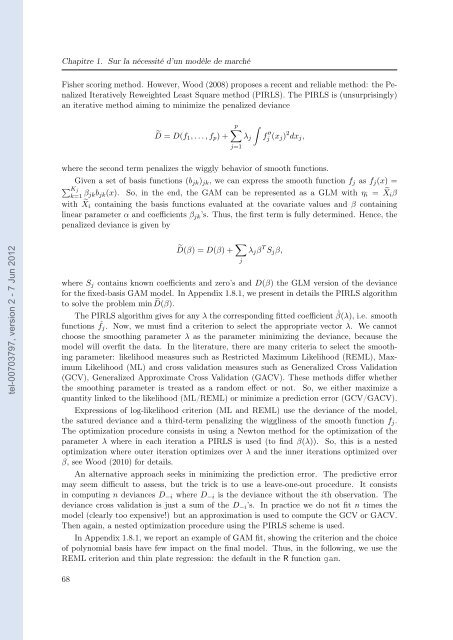Etude des marchés d'assurance non-vie à l'aide d'équilibres de ...
Etude des marchés d'assurance non-vie à l'aide d'équilibres de ...
Etude des marchés d'assurance non-vie à l'aide d'équilibres de ...
Create successful ePaper yourself
Turn your PDF publications into a flip-book with our unique Google optimized e-Paper software.
tel-00703797, version 2 - 7 Jun 2012<br />
Chapitre 1. Sur la nécessité d’un modèle <strong>de</strong> marché<br />
Fisher scoring method. However, Wood (2008) proposes a recent and reliable method: the Penalized<br />
Iteratively Reweighted Least Square method (PIRLS). The PIRLS is (unsurprisingly)<br />
an iterative method aiming to minimize the penalized <strong>de</strong>viance<br />
D = D(f1, . . . , fp) +<br />
p<br />
j=1<br />
λj<br />
<br />
f ′′<br />
j (xj) 2 dxj,<br />
where the second term penalizes the wiggly behavior of smooth functions.<br />
Given a set of basis functions (bjk)jk, we can express the smooth function fj as fj(x) =<br />
Kj<br />
k=1 βjkbjk(x). So, in the end, the GAM can be represented as a GLM with ηi = Xiβ<br />
with Xi containing the basis functions evaluated at the covariate values and β containing<br />
linear parameter α and coefficients βjk’s. Thus, the first term is fully <strong>de</strong>termined. Hence, the<br />
penalized <strong>de</strong>viance is given by<br />
D(β) = D(β) + <br />
λjβ T Sjβ,<br />
where Sj contains known coefficients and zero’s and D(β) the GLM version of the <strong>de</strong>viance<br />
for the fixed-basis GAM mo<strong>de</strong>l. In Appendix 1.8.1, we present in <strong>de</strong>tails the PIRLS algorithm<br />
to solve the problem min D(β).<br />
The PIRLS algorithm gives for any λ the corresponding fitted coefficient ˆ β(λ), i.e. smooth<br />
functions ˆ fj. Now, we must find a criterion to select the appropriate vector λ. We cannot<br />
choose the smoothing parameter λ as the parameter minimizing the <strong>de</strong>viance, because the<br />
mo<strong>de</strong>l will overfit the data. In the literature, there are many criteria to select the smoothing<br />
parameter: likelihood measures such as Restricted Maximum Likelihood (REML), Maximum<br />
Likelihood (ML) and cross validation measures such as Generalized Cross Validation<br />
(GCV), Generalized Approximate Cross Validation (GACV). These methods differ whether<br />
the smoothing parameter is treated as a random effect or not. So, we either maximize a<br />
quantity linked to the likelihood (ML/REML) or minimize a prediction error (GCV/GACV).<br />
Expressions of log-likelihood criterion (ML and REML) use the <strong>de</strong>viance of the mo<strong>de</strong>l,<br />
the satured <strong>de</strong>viance and a third-term penalizing the wiggliness of the smooth function fj.<br />
The optimization procedure consists in using a Newton method for the optimization of the<br />
parameter λ where in each iteration a PIRLS is used (to find β(λ)). So, this is a nested<br />
optimization where outer iteration optimizes over λ and the inner iterations optimized over<br />
β, see Wood (2010) for <strong>de</strong>tails.<br />
An alternative approach seeks in minimizing the prediction error. The predictive error<br />
may seem difficult to assess, but the trick is to use a leave-one-out procedure. It consists<br />
in computing n <strong>de</strong>viances D−i where D−i is the <strong>de</strong>viance without the ith observation. The<br />
<strong>de</strong>viance cross validation is just a sum of the D−i’s. In practice we do not fit n times the<br />
mo<strong>de</strong>l (clearly too expensive!) but an approximation is used to compute the GCV or GACV.<br />
Then again, a nested optimization procedure using the PIRLS scheme is used.<br />
In Appendix 1.8.1, we report an example of GAM fit, showing the criterion and the choice<br />
of polynomial basis have few impact on the final mo<strong>de</strong>l. Thus, in the following, we use the<br />
REML criterion and thin plate regression: the <strong>de</strong>fault in the R function gam.<br />
68<br />
j
















